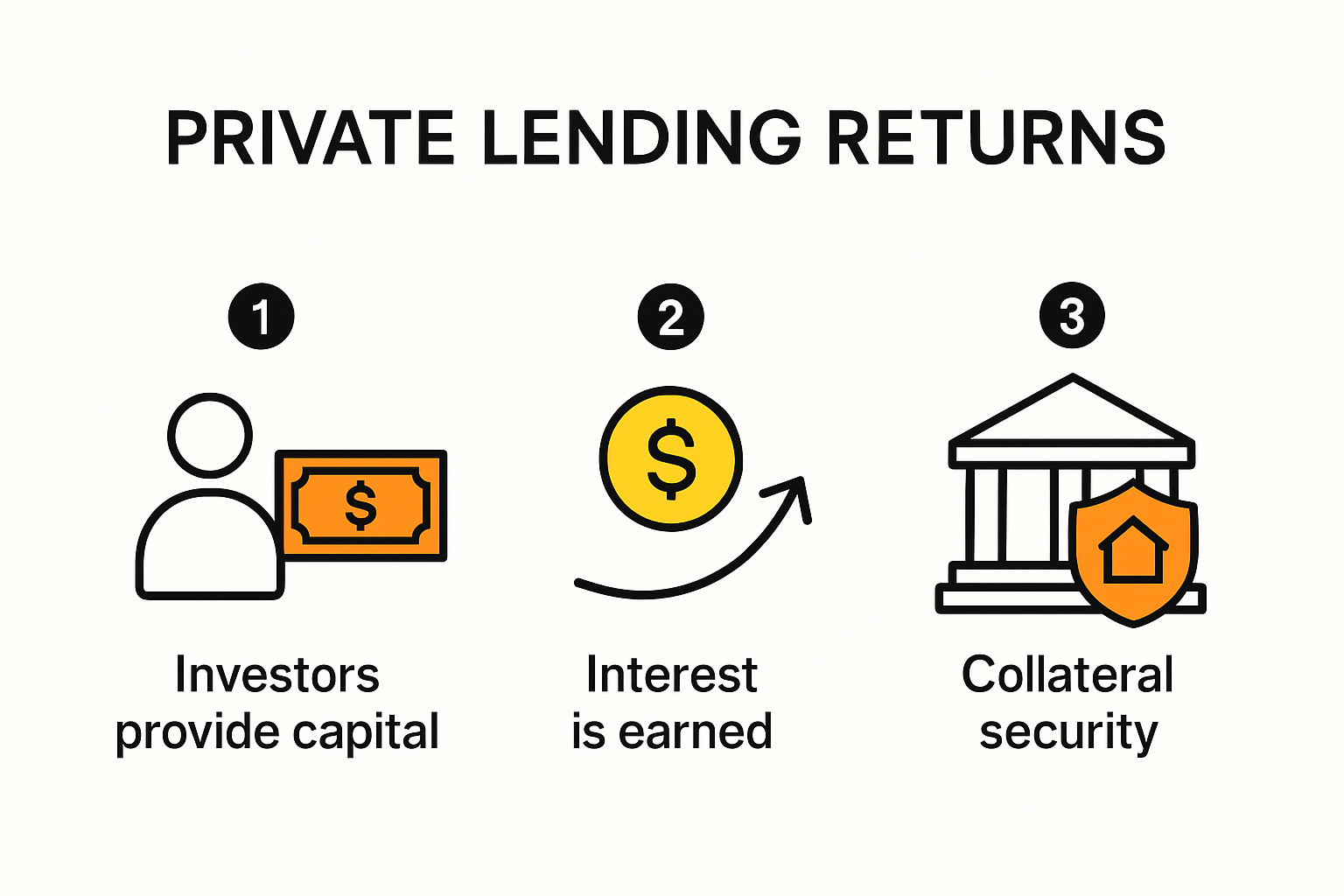
Private lending is making waves among expats and investors, especially in markets like Costa Rica where banking hurdles are common. Surprised? Most people expect only modest returns from lending, but private loans here can deliver annual yields of 12% to 18%—sometimes triple the average US stock market performance. And the real surprise is how the right strategies can make these returns not just possible but surprisingly stable, even when traditional investments take a hit.
Table of Contents
- How Private Lending Returns Work
- Key Factors Impacting Your Returns
- Comparing Private Lending To Other Investments
- Tips For Maximizing Returns In Costa Rica
Quick Summary
| Takeaway | Explanation |
|---|---|
| Understanding Private Lending Returns | Private lending offers competitive returns ranging from 12% to 18% annually by providing direct loans secured by tangible assets, unlike traditional banking options. |
| Effective Risk Management | Comprehensive risk assessments, including borrower evaluations and collateral verification, are essential to mitigate losses and ensure stable returns in private lending. |
| Comparative Advantages | Private lending provides predictable income streams and collateral-backed loans, offering more stability compared to volatile stock market investments. |
| Focus on Local Ecosystems | Mastering Costa Rica’s unique real estate market dynamics, including regional property values and economic trends, is crucial for maximizing investment returns. |
| Adapting Investment Strategies | Investors should adopt flexible, diversified portfolios across various property types and timelines while leveraging local networks and technology to enhance decision-making. |
How Private Lending Returns Work
Private lending returns represent a sophisticated investment strategy where individuals and institutions generate income by providing direct loans outside traditional banking systems. Unlike standard investment vehicles, private lending offers investors the opportunity to earn competitive returns by directly funding loans secured by tangible assets.
Understanding the Core Mechanics of Private Lending
At its fundamental level, private lending works through a direct financial transaction between an investor and a borrower. Investors provide capital directly to borrowers who might not qualify for traditional bank financing, receiving interest payments in return. These loans are typically backed by real estate or other valuable collateral, which significantly reduces the risk for the lender.

The return structure in private lending is relatively straightforward. Investors earn money through interest payments, which are often calculated at higher rates compared to conventional banking products. Interest rates can range from 12% to 18% annually, depending on the specific loan’s risk profile, loan term, and underlying asset quality. This higher return compensates investors for taking on more direct lending risk and providing more flexible financing options.
Risk Mitigation and Return Potential
Successful private lending returns depend on robust risk management strategies. Experienced private lenders focus on thorough property valuations, comprehensive borrower assessments, and securing first-lien positions on collateral. These precautions help protect the investor’s principal while ensuring a steady income stream.
Key risk mitigation techniques include:
- Collateral Verification: Conducting detailed property assessments to confirm asset value and marketability
- Borrower Screening: Evaluating borrower financial history, income stability, and repayment capacity
- Legal Protections: Establishing clear legal frameworks that provide recourse in case of default
Investors can further optimize their returns by diversifying across multiple loans and maintaining a disciplined approach to capital allocation. Learn more about private lending strategies that can help maximize investment potential while minimizing risks.
Calculating Potential Returns
Calculating potential private lending returns involves analyzing several critical factors. Investors must consider the loan’s interest rate, duration, collateral quality, and the borrower’s financial profile. A typical private lending investment might generate annual returns between 12% to 18%, significantly outperforming many traditional investment options like savings accounts or government bonds.
For example, a $100,000 loan at 15% annual interest would generate $15,000 in returns over a single year, assuming consistent performance and timely repayments. However, investors must also factor in potential transaction costs, legal fees, and the possibility of loan restructuring or default.
Private lending returns are not guaranteed and require careful due diligence. Successful investors approach these opportunities with a strategic mindset, understanding both the potential rewards and inherent risks involved in direct lending. By maintaining a disciplined investment approach and working with experienced platforms, investors can effectively navigate the private lending landscape and generate meaningful passive income.

Key Factors Impacting Your Returns
Private lending returns are not a simple passive investment strategy but a complex financial mechanism influenced by multiple interconnected factors. Understanding these variables is crucial for investors seeking to optimize their potential earnings and manage risk effectively in the private lending ecosystem.
Loan Characteristics and Structural Elements
The fundamental structure of a private loan significantly determines its return potential. Interest rates, loan duration, collateral quality, and borrower profile are critical components that directly impact investment performance. Short-term loans typically offer higher interest rates but require more active management, while longer-term investments provide more stability but potentially lower annual returns.
Investors must carefully analyze the loan’s terms, including interest rate calculation methods, payment schedules, and potential prepayment penalties. Variable-rate loans can offer flexibility but introduce additional uncertainty into return calculations. Fixed-rate loans provide more predictable income streams but might lock investors into lower returns if market conditions improve.
Risk Assessment and Mitigation Strategies
Risk management represents the cornerstone of successful private lending investments. Comprehensive risk assessment involves multiple layers of evaluation, including borrower financial health, collateral valuation, and broader economic conditions. Experienced investors develop robust screening processes that go beyond surface-level financial metrics.
Key risk mitigation techniques include:
- Comprehensive Borrower Screening: Detailed analysis of credit history, income stability, and repayment capacity
- Asset Valuation: Rigorous property assessment and verification of collateral value
- Legal Protection: Establishing first-lien positions and comprehensive loan agreements
Explore comprehensive investment strategies that can help investors navigate the complex private lending landscape effectively.
Economic and Market Dynamics
External economic factors play a crucial role in determining private lending returns. Interest rate fluctuations, regional economic stability, real estate market trends, and broader financial market conditions can significantly impact investment performance. Successful investors maintain a dynamic approach, continuously monitoring economic indicators and adapting their strategies accordingly.
Inflation rates, central bank policies, and regional economic development directly influence private lending returns. For instance, periods of economic uncertainty might increase demand for private lending as traditional banking becomes more restrictive. Conversely, stable economic conditions can reduce interest rates and potentially compress returns.
Sophisticated investors develop diversification strategies that spread risk across multiple loans, sectors, and geographic regions. This approach helps mitigate potential downturns in specific markets while maintaining the potential for robust returns. Understanding these complex interactions requires continuous learning, market research, and a willingness to adapt investment strategies.
Private lending returns are not guaranteed and require a proactive, informed approach. By developing a deep understanding of these key factors, investors can position themselves to maximize potential earnings while managing inherent risks effectively. Success in private lending demands a combination of financial acumen, thorough research, and strategic decision-making.
Comparing Private Lending to Other Investments
Investors navigating the complex financial landscape seek strategies that offer robust returns while managing risk effectively. Private lending emerges as a compelling alternative investment strategy, distinguishing itself from traditional investment vehicles through unique characteristics and potential performance advantages.
Performance Metrics and Return Potential
Private lending consistently demonstrates competitive return profiles compared to conventional investment options. While traditional savings accounts and government bonds typically offer minimal returns ranging from 1% to 3% annually, private lending investments can generate substantially higher yields between 12% to 18%. Stock market investments present volatile returns with average annual performances around 7% to 10%, subject to significant market fluctuations.
The predictability of private lending returns sets it apart from more speculative investment approaches. Unlike stock markets, which can experience dramatic price swings, private lending offers more structured and consistent income streams. Investors benefit from predetermined interest rates and clearly defined repayment schedules, providing greater financial certainty.
Below is a table summarizing how private lending returns compare with other common investment options discussed in this section:
| Investment Type | Average Annual Return | Return Predictability | Risk Level | Security/Collateral |
|---|---|---|---|---|
| Private Lending | 12% – 18% | High (fixed interest) | Moderate | Real estate collateralized |
| Stock Market | 7% – 10% | Low (volatile) | Moderate to High | None (unless margin) |
| Government Bonds | 1% – 3% | High | Low | Government-backed |
| Savings Accounts | 1% – 2% | Very High | Very Low | Bank-backed |
Risk Assessment and Diversification
Risk management represents a critical differentiator in private lending investments. Traditional investment vehicles like mutual funds and exchange-traded funds distribute risk across multiple securities, but private lending offers unique risk mitigation through direct collateral backing. Real estate secured loans provide tangible asset protection, reducing potential losses compared to unsecured investment instruments.
Key comparative advantages include:
- Collateral Security: Direct property-backed loans offering lower default risks
- Income Stability: More predictable returns compared to stock market investments
- Lower Correlation: Less vulnerability to broader market volatility
Discover advanced investment comparison strategies that can help you make informed financial decisions.
Investment Flexibility and Accessibility
Private lending stands out for its flexibility and accessibility compared to other investment strategies. Traditional investment vehicles often require significant minimum investments or complex qualification processes. Private lending allows investors to participate with more modest capital amounts and provides more direct control over investment selection.
The liquidity profile of private lending differs markedly from standard investments. While stock markets offer immediate trading capabilities, private loans typically involve longer-term commitments. This characteristic attracts investors seeking steady, predictable income streams rather than rapid capital appreciation. Sophisticated investors appreciate the ability to customize loan terms, select specific risk profiles, and maintain more granular control over their investment portfolios.
Unlike mutual funds or retirement accounts with predetermined allocation strategies, private lending empowers investors to make targeted, informed decisions. The transparency of direct lending allows for more comprehensive risk assessment and strategic planning. Investors can evaluate individual loan opportunities, borrower profiles, and specific collateral details before committing capital.
While no investment strategy guarantees absolute returns, private lending offers a compelling alternative for investors seeking balanced risk-reward propositions. By understanding the nuanced differences between various investment approaches, individuals can develop more robust, diversified investment strategies that align with their financial goals and risk tolerance.
Tips for Maximizing Returns in Costa Rica
Investing in private lending within Costa Rica requires a strategic approach that combines local market knowledge, robust risk management, and a deep understanding of regional economic dynamics. Successful investors recognize that maximizing returns goes beyond simple financial transactions and demands a comprehensive investment strategy tailored to the unique Costa Rican market landscape.
Understanding the Local Real Estate Ecosystem
Mastering the intricacies of Costa Rica’s real estate market represents the foundation of successful private lending investments. The country’s diverse property landscape ranges from coastal properties and urban developments to agricultural lands, each presenting distinct investment opportunities and risk profiles. Investors must develop a nuanced understanding of regional property values, emerging development zones, and economic growth corridors.
Local market research is critical. Investors should focus on areas experiencing consistent economic development, infrastructure improvements, and increasing property valuations. Regions like the Central Valley, coastal areas around Guanacaste, and emerging urban centers offer particularly promising investment environments. Understanding local zoning regulations, property ownership laws, and potential future development plans can provide significant competitive advantages.
Risk Mitigation and Due Diligence Strategies
Rigorous risk management distinguishes successful private lending investors from amateur participants. Comprehensive due diligence involves multiple layers of verification and assessment. This includes thorough borrower background checks, detailed property valuations, and comprehensive legal documentation that provides robust protection for investors.
Key risk mitigation techniques specific to the Costa Rican market include:
- Property Valuation: Obtaining independent, professional property assessments
- Legal Verification: Confirming clear property titles and potential encumbrances
- Borrower Screening: Conducting comprehensive financial and personal background investigations
Below is a table summarizing key due diligence steps and their benefits for private lending in Costa Rica:
| Due Diligence Step | Purpose/Benefit |
|---|---|
| Property Valuation | Ensures accurate asset value and safeguards investment |
| Legal Verification | Confirms ownership/title and identifies legal risks |
| Borrower Screening | Assesses financial reliability and repayment capacity |
Explore advanced investment strategies for Costa Rica that can help you navigate the local lending landscape effectively.
Strategic Investment Approach
Successful private lending in Costa Rica demands a strategic, adaptive investment approach. Investors should develop a diversified portfolio that spreads risk across different property types, geographical regions, and loan terms. This approach helps mitigate potential market fluctuations and provides more stable, consistent returns.
Understanding the local economic indicators is crucial. Factors such as tourism trends, foreign investment patterns, infrastructure development, and government economic policies directly impact private lending returns. Investors who maintain close connections with local real estate professionals, legal experts, and economic analysts can make more informed investment decisions.
Technology and local network connections play increasingly important roles in maximizing investment returns. Sophisticated investors leverage digital platforms for loan origination, utilize advanced data analytics for risk assessment, and maintain strong relationships with local legal and financial professionals.
Private lending in Costa Rica offers compelling opportunities for investors willing to invest time, resources, and expertise into understanding the local market. By combining thorough research, strategic risk management, and a deep appreciation for the region’s unique economic landscape, investors can position themselves to generate robust, sustainable returns in this dynamic market.
Frequently Asked Questions
What are private lending returns?
Private lending returns refer to the income generated by directly funding loans secured by tangible assets, typically offering annual yields between 12% to 18%.
How do I calculate potential returns from private lending?
To calculate potential returns, consider the loan’s interest rate, duration, collateral quality, and the borrower’s financial profile. For example, a $100,000 loan at 15% interest would yield $15,000 in a year if repayments are consistent.
What are the risks associated with private lending?
Risks include borrower default, fluctuating property values, and potential economic downturns. Effective risk management strategies, such as thorough borrower screening and collateral verification, can help mitigate these risks.
How does private lending compare to traditional investments?
Private lending generally offers higher returns (12% – 18%) compared to traditional investments like government bonds (1% – 3%) and bank savings accounts (1% – 2%), while providing more predictable income streams through secured loans.
Unlock Stable High-Yield Returns in Costa Rica’s Private Lending Market
Tired of unpredictable markets and limited investment opportunities? This guide on private lending returns highlights a real struggle expats and investors face: finding secure, high-yield income outside traditional banking, especially when bank financing is out of reach or too slow. If you want steady annual yields of 12% to 18%, backed by real collateral and first-lien security, CostaRicaLoanExperts.net bridges that gap. We provide you with transparent access to vetted loans and streamlined investment tools, tailored specifically for Costa Rica’s unique real estate market.

Take control of your financial goals now. If you want detailed insights on private lending best practices or ready to explore real estate investment returns, tap into our trusted network to get started. Visit CostaRicaLoanExperts.net and connect with the experts who secure your investments and guide you every step of the way.
Recommended
- private lending opportunities 2025 – costaricaloanexperts.net
- Private Lending Best Practices for Expats and Investors 2025 – costaricaloanexperts.net
- Private Lending Opportunities 2025: Smart Strategies for Expats & Investors – costaricaloanexperts.net
- private lending best practices – costaricaloanexperts.net
- Exploring Alternative Financing: How Small Businesses Can Secure Capital In 2024
- Stock Market for Beginners: Easy Guide for South Africa & Botswana 2025 – SA’s Best Forex Trading Course & Coaching Classes
